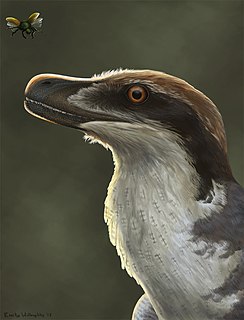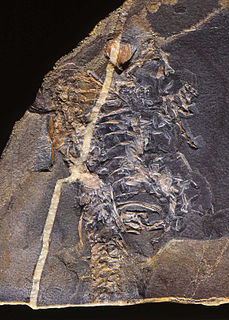 W
WThe evolution of tetrapods began about 400 million years ago in the Devonian Period with the earliest tetrapods evolved from lobe-finned fishes. Tetrapods are categorized as animals in the biological superclass Tetrapoda, which includes all living and extinct amphibians, reptiles, birds, and mammals. While most species today are terrestrial, little evidence supports the idea that any of the earliest tetrapods could move about on land, as their limbs could not have held their midsections off the ground and the known trackways do not indicate they dragged their bellies around. Presumably, the tracks were made by animals walking along the bottoms of shallow bodies of water. The specific aquatic ancestors of the tetrapods, and the process by which land colonization occurred, remain unclear. They are areas of active research and debate among palaeontologists at present.
 W
WEotetrapodiformes is a clade of sarcopterygian fish including tetrapods and their immediate ancestors, two groups of stem tetrapods called tristichopterids and elpistostegalids. Eotetrapodiformes is part of the larger clade Tetrapodomorpha, but exclude the basalmost tetrapodomorphs, such as megalichthyiforms.
 W
WA feathered dinosaur is any species of dinosaur possessing feathers. While this includes all species of birds, there is a hypothesis that many, if not all non-avian dinosaur species also possessed feathers in some shape or form.
 W
WIchthyostega is an early genus of tetrapodomorphs that lived at the end of the Late Devonian Period. It was one of the first four-limbed vertebrates in the fossil record. Ichthyostega possessed lungs and limbs that helped it navigate through shallow water in swamps. Although Ichthyostega is often labelled a "tetrapod" due to the possession of limbs and fingers, it was more basal ("primitive") than true crown-tetrapods, and could more accurately be referred to as a stegocephalian or stem tetrapod. Likewise, while undoubtedly of amphibian build and habit, it is not considered a true member of the group in the narrow sense, as the first modern amphibians appeared in the Triassic Period. Until finds of other early stegocephalians and closely related fishes in the late 20th century, Ichthyostega stood alone as a transitional fossil between fish and tetrapods, combining fish- and tetrapod-like features. Newer research has shown that it had an unusual anatomy, functioning more akin to a seal than a salamander, as previously assumed.
 W
WSeveral non-avian dinosaurs were feathered. Direct evidence of feathers exists for the following species, listed in the order currently accepted evidence was first published. In all examples, the evidence described consists of feather impressions, except those genera inferred to have had feathers based on skeletal or chemical evidence, such as the presence of quill knobs or a pygostyle.Ostromia crassipes Avimimus portentosus Sinosauropteryx prima (1996) Fulicopus lyellii, an ichnotaxon, possible squatting Dilophosaurus or similar (1996) Protarchaeopteryx robusta (1997) GMV 2124 (1997) Caudipteryx zoui (1998) Rahonavis ostromi Shuvuuia deserti (1999) Beipiaosaurus inexpectus (1999) Sinornithosaurus millenii (1999) Caudipteryx dongi (2000) Caudipteryx sp. (2000) Microraptor zhaoianus (2000) Nomingia gobiensis Psittacosaurus sp.? (2002) Scansoriopteryx heilmanni IVPP V13476 (2003) Yixianosaurus longimanus Dilong paradoxus (2004) Pedopenna daohugouensis Jinfengopteryx elegans (2005) Juravenator starki (2006) Sinocalliopteryx gigas (2007) Velociraptor mongoliensis Epidexipteryx hui Similicaudipteryx yixianensis Anchiornis huxleyi Tianyulong confuciusi? (2009) Incisivosaurus sp. (2010) Concavenator corcovatus? Xiaotingia zhengi Yutyrannus huali (2012) Sciurumimus albersdoerferi (2012) Ornithomimus edmontonicus (2012) Ningyuansaurus wangi (2012) Eosinopteryx brevipenna Jianchangosaurus yixianensis (2013) Aurornis xui Changyuraptor yangi (2014) Kulindadromeus zabaikalicus? (2014) Citipati osmolskae Conchoraptor gracilis Deinocheirus mirificus? Yi qi Ornithomimus sp. (2015) Zhenyuanlong suni (2015) Dakotaraptor steini Apatoraptor pennatus DIP-V-15103 Jianianhualong tengi (2017) Serikornis sungei Caihong juji Xingtianosaurus ganqi (2019) Ambopteryx longibrachium Wulong bohaiensis (2020) Chirostenotes pergracilis? (2020) Dineobellator notohesperus Ubirajara jubatus (2020)Note that the filamentous structures in some ornithischian dinosaurs and the pycnofibres found in some pterosaurs may or may not be homologous with the feathers of theropods.
 W
WPolydactyly in stem-tetrapods should here be understood as having more than five digits to the finger or foot, a condition that was the natural state of affairs in the very first stegocephalians during the evolution of terrestriality. The polydactyly in these largely aquatic animals is not to be confused with polydactyly in the medical sense, i.e. it was not an anomaly in the sense it was not a congenital condition of having more than the typical number of digits for a given taxon. Rather, it appears to be a result of the early evolution from a limb with a fin rather than digits.
 W
WReptiles arose about 310–320 million years ago during the Carboniferous period. Reptiles, in the traditional sense of the term, are defined as animals that have scales or scutes, lay land-based hard-shelled eggs, and possess ectothermic metabolisms. So defined, the group is paraphyletic, excluding endothermic animals like birds and mammals that are descended from early traditionally-defined reptiles. A definition in accordance with phylogenetic nomenclature, which rejects paraphyletic groups, includes birds while excluding mammals and their synapsid ancestors. So defined, Reptilia is identical to Sauropsida.
 W
WRhipidistia, also known as Dipnotetrapodomorpha, is a clade of lobe-finned fishes which includes the tetrapods and lungfishes. Rhipidistia formerly referred to a subgroup of Sarcopterygii consisting of the Porolepiformes and Osteolepiformes, a definition that is now obsolete. However as cladistic understanding of the vertebrates has improved over the last few decades, a monophyletic Rhipidistia is now understood to include the whole of Tetrapoda and the lungfishes.
 W
WVenom in snakes and some lizards is a form of saliva that has been modified into venom over its evolutionary history. In snakes, venom has evolved to kill or subdue prey, as well as to perform other diet-related functions. The evolution of venom is thought to be responsible for the enormous expansion of snakes across the globe.
 W
WTiktaalik is a monospecific genus of extinct sarcopterygian from the Late Devonian Period, about 375 Mya, having many features akin to those of tetrapods.